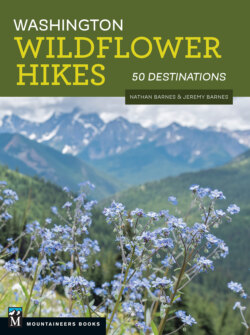Читать книгу Washington Wildflower Hikes - Nathan Barnes - Страница 13
На сайте Литреса книга снята с продажи.
The Ten Essentials
ОглавлениеThe point of the Ten Essentials, originated by The Mountaineers, has always been to answer two basic questions: Can you prevent emergencies and respond positively should one occur (items 1–5)? And can you safely spend a night—or more—outside (items 6–10)? Use this list as a guide and tailor it to the needs of your outing.
1.Navigation: The five fundamentals are a map, altimeter, compass, GPS device, and a personal locator beacon or other device to contact emergency first responders.
2.Headlamp: Include spare batteries.
3.Sun protection: Wear sunglasses, sun-protective clothes, and broadspectrum sunscreen rated at least SPF 30.
4.First aid: Basics include bandages; skin closures; gauze pads and dressings; roller bandage or wrap; tape; antiseptic; blister prevention and treatment supplies; nitrile gloves; tweezers; needle; nonprescription painkillers; anti-inflammatory, antidiarrheal, and antihistamine tablets; topical antibiotic; and any important personal prescriptions, including an EpiPen if you are allergic to bee or hornet venom.
5.Knife: Also consider a multitool, strong tape, some cordage, and gear repair supplies.
6.Firestarter: Carry at least one butane lighter (or waterproof matches) and firestarter, such as chemical heat tabs, cotton balls soaked in petroleum jelly, or commercially prepared firestarter.
7.Shelter: In addition to a rain shell, carry a single-use bivy sack, plastic tube tent, or jumbo plastic trash bag.
8.Extra food: For shorter trips a one-day supply is reasonable.
9.Extra water: Carry sufficient water and have the skills and tools required to obtain and purify additional water.
10.Extra clothes: Pack additional layers needed to survive the night in the worst conditions that your party may realistically encounter.
Glaciated Mount Rainier looms large above Paradise Meadows (Hike 35).
While there are few right answers to the question of exactly what gear to bring, there are certainly wrong answers. Here are a few general gear and supply suggestions to help you avoid some common pitfalls:
•Do not wear sandals or lightweight tennis shoes: These footwear choices unnecessarily increase the risk of foot injury and make it harder to navigate the trail. Wear lugged-sole hiking sneakers or, for rugged trails, waterproof or water-resistant hiking boots for ankle protection and traction on rocky terrain.
•Do not wear clothing that is restrictive, difficult to move in, or not functional. Avoid wearing something that will make it more difficult to survive a night in the wilderness.
•Do not carry food on overnight trips without a way to secure it from scavengers and bears. Always bring a bear can or a sturdy sack and a length of rope to tie up your food.
